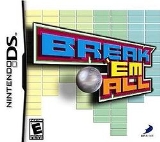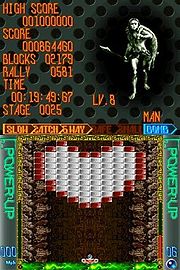
Break 'Em All
Encyclopedia
Break 'Em All is an Arkanoid
clone released in 2005 for the Nintendo DS
. The game features several single player modes, as well as single-cart multiplayer for up to 8 players. The game utilized the system's touch screen to control the paddle, as well as activate power-ups. Power-Ups could also be activated by pressing left on the D-Pad
or by pressing the L Button.
The game was originally released on October 27, 2005 in Japan as part of the "Simple DS" line of products. In early 2006, D3 Publisher
announced that it would be releasing a localized version of the game in North America
under the name "Break 'Em All".
 Tokoton mode is one of the two single player modes in the game. It has two play options: "Standard Play" and "Random Play". Standard play consists of 50 stages. As the player progresses through the stages, they begin to gain levels. The player begins at the "amoeba
Tokoton mode is one of the two single player modes in the game. It has two play options: "Standard Play" and "Random Play". Standard play consists of 50 stages. As the player progresses through the stages, they begin to gain levels. The player begins at the "amoeba
" level and slowly works their way to the "superior being" level. In "Random Play", the game randomly generates each level, with a total of over 3 million different combinations. In Tokoton Mode, the player is given three lives at the beginning, and can earn more as the game progresses.
-style games. This mode chooses to forego the normal Arkanoid
brick-breaking mode of play. Instead, players must dodge balls and obstacles thrown at them. The last player to survive the round without being hit is the winner.
Upon its release, the game was generally met with mixed to poor reviews. Many criticized the game's low production quality, as evidenced by its poor visuals, low sound quality and lackluster, rushed translation from the Japanese version. Many also felt that the game failed to add anything new to the genre, instead acting as a retread of what other games have done in the past.
However, many critics were impressed by the game's range of options, modes, and its inclusion of 8-player single-cart multiplayer. Some reviews also took the game's low $19.99 price into account, believing the game to be of sufficient value for the price. In his review, GameSpot's Alex Nevarro also praised the game's tight, responsive controls and intuitive use of the system's touch screen to control the paddle.
As of August 17, 2008 the game holds a 68/100 rating at Metacritic
.
Arkanoid
is an arcade game developed by Taito in 1986. It is based upon Atari's Breakout games of the 1970s. The title refers to a doomed "mothership" from which the player's ship, the Vaus, escapes.-Overview:...
clone released in 2005 for the Nintendo DS
Nintendo DS
The is a portable game console produced by Nintendo, first released on November 21, 2004. A distinctive feature of the system is the presence of two separate LCD screens, the lower of which is a touchscreen, encompassed within a clamshell design, similar to the Game Boy Advance SP...
. The game features several single player modes, as well as single-cart multiplayer for up to 8 players. The game utilized the system's touch screen to control the paddle, as well as activate power-ups. Power-Ups could also be activated by pressing left on the D-Pad
D-pad
A D-pad is a flat, usually thumb-operated directional control with one button on each point, found on nearly all modern video game console gamepads, game controllers, on the remote control units of some television and DVD players, and smart phones...
or by pressing the L Button.
The game was originally released on October 27, 2005 in Japan as part of the "Simple DS" line of products. In early 2006, D3 Publisher
D3 Publisher
D3Publisher is a Japanese video game publisher founded on February 5, 1992. Current CEO and president is Yuji Ito, and It is known for its Simple series of low-priced console games. Their games have been released for the Game Boy Advance, Nintendo DS, PlayStation Portable, PlayStation 2,...
announced that it would be releasing a localized version of the game in North America
North America
North America is a continent wholly within the Northern Hemisphere and almost wholly within the Western Hemisphere. It is also considered a northern subcontinent of the Americas...
under the name "Break 'Em All".
Tokoton Mode

Amoeba
Amoeba is a genus of Protozoa.History=The amoeba was first discovered by August Johann Rösel von Rosenhof in 1757. Early naturalists referred to Amoeba as the Proteus animalcule after the Greek god Proteus, who could change his shape...
" level and slowly works their way to the "superior being" level. In "Random Play", the game randomly generates each level, with a total of over 3 million different combinations. In Tokoton Mode, the player is given three lives at the beginning, and can earn more as the game progresses.
Quest Mode
The game's second single-player mode is Quest Mode. Quest Mode consists of 12 levels, with each level having three regular stages and one special boss stage. To defeat the boss, the player must find and exploit its weak point. Quest Mode can also be played as a multiplayer portion. Up to four players can play through the mode separately, with the player with the highest score being the winner.Survival Mode
Survival Mode is the game's multiplayer mode. Up to eight players can participate. At the beginning of the round, they each chose one of four unique paddles to play as. Each paddle is shaped differently than the standard flat paddle found in most BreakoutBreakout (video game)
Breakout is an arcade game developed by Atari, Inc and introduced on May 13, 1976. It was conceptualized by Nolan Bushnell and Steve Bristow, and influenced by the 1972 arcade game Pong, also by Atari. The game was ported to video game consoles and upgraded to video games such as Super Breakout...
-style games. This mode chooses to forego the normal Arkanoid
Arkanoid
is an arcade game developed by Taito in 1986. It is based upon Atari's Breakout games of the 1970s. The title refers to a doomed "mothership" from which the player's ship, the Vaus, escapes.-Overview:...
brick-breaking mode of play. Instead, players must dodge balls and obstacles thrown at them. The last player to survive the round without being hit is the winner.
Power-Ups
Like many other brick-breaking games, Break 'Em All utilizes a power-up system that allows players to modify gameplay to help them progress. The game's 12 power-ups are divided into six pairs of two, and at the beginning of each game the player must choose one of each pair. During the game, the power-ups become available in order of usefulness as the player's points increase, although only the most recently gained powerup is available for use. If a player completes a stage without using a powerup, it will carry over to the next stage. While most powerups are meant to make the game easier, some powerups make the game more difficult, but give the player a boost in points.| Tier | Choice #1 | Choice #2 |
|---|---|---|
| Tier 1 | Slow Decreases ball speed. |
Fast Increases ball speed and score obtained by each broken block. |
| Tier 2 | Catch Catches the ball with the paddle. |
Mirror Reflects the ball back in the direction it came from. |
| Tier 3 | Multi Makes two additional clones of the ball. |
5-Way Temporarily splits the ball into 5 parts. |
| Tier 4 | Safe Extends a barrier behind the paddle. |
Option Makes a clone of your paddle where you activate this power-up. |
| Tier 5 | Wide Extends the length of the paddle. |
Small Decreases the length of the paddle but doubles the points for each broken block. |
| Tier 6 | Laser Temporarily gives the ball the ability to obliterate any breakable brick in its path. |
Bomb Temporarily gives the ball the ability to destroy adjacent bricks. |
Reception
| Xbox 360 and PlayStation 3 | |
|---|---|
| Publication | Score |
| 1UP.com 1UP.com 1UP.com is a video game website owned by IGN Entertainment, a division of News Corporation. Previously, the site was owned by Ziff Davis before being sold to UGO Entertainment in 2009.... |
C+ |
| GameInformer | 75/100 |
| GameSpot GameSpot GameSpot is a video gaming website that provides news, reviews, previews, downloads, and other information. The site was launched in May 1, 1996 by Pete Deemer, Vince Broady and Jon Epstein. It was purchased by ZDNet, a brand which was later purchased by CNET Networks. CBS Interactive, which... |
6.3/10 |
| IGN IGN IGN is an entertainment website that focuses on video games, films, music and other media. IGN's main website comprises several specialty sites or "channels", each occupying a subdomain and covering a specific area of entertainment... |
6.5/10 |
| Nintendo Power Nintendo Power Nintendo Power magazine is a monthly news and strategy magazine formerly published in-house by Nintendo of America, but now run independently. As of issue #222 , Nintendo contracted publishing duties to Future US, the U.S. subsidiary of British publisher Future.The first issue published was... |
7/10 |
Upon its release, the game was generally met with mixed to poor reviews. Many criticized the game's low production quality, as evidenced by its poor visuals, low sound quality and lackluster, rushed translation from the Japanese version. Many also felt that the game failed to add anything new to the genre, instead acting as a retread of what other games have done in the past.
However, many critics were impressed by the game's range of options, modes, and its inclusion of 8-player single-cart multiplayer. Some reviews also took the game's low $19.99 price into account, believing the game to be of sufficient value for the price. In his review, GameSpot's Alex Nevarro also praised the game's tight, responsive controls and intuitive use of the system's touch screen to control the paddle.
As of August 17, 2008 the game holds a 68/100 rating at Metacritic
Metacritic
Metacritic.com is a website that collates reviews of music albums, games, movies, TV shows and DVDs. For each product, a numerical score from each review is obtained and the total is averaged. An excerpt of each review is provided along with a hyperlink to the source. Three colour codes of Green,...
.
Personnel
- Daisei Saitoh - Producer
- Kayoko Maeda - Assistant Producer
- Toshihiko Nakamura - Graphic Design
- Toshihiko Kudo - Graphic Design
- Dota Ando - Sound Design
- Nobumasa Oikawa - Game Design
- Shotaroh Sasaki - Localization

